Abstract
Accidental contamination of the food chain in Michigan in 1973 with polybrominated biphenyls (PBBs) led to the establishment of a registry of exposed individuals in 1976. Serum was collected and analyzed for PBB at the time of enrollment and for targeted studies in the following years. We used the archived PBB data to study the elimination of PBB and to identify factors associated with elimination. A total of 380 women >= 16 years of age who had an initial PBB level of 2 ppb and at least two serum samples drawn when they were not pregnant were included in the analysis. The mean initial PBB level was 20.9 ppb (median 4) and mean time between the first and last measurement was 4.2 years (range 0.5-11.1). PBB was assumed to reach equilibrium in the body before substantial amounts were eliminated and before the first serum measurements were taken; therefore, the entire body was modeled as a single compartment for PBB with exponential decay. Subject-specific decay rate estimates were regressed on predictor variables including initial age, body mass index (BMI), smoking history, breast-feeding duration, and parity. In women with an initial PBB level < 10 ppb, the median half-life was 12.9 years; in those with > 10 ppb, the median half-life was 28.7 years. Decay was significantly slower among women with an initial BMI at or above the median (BMI >= 23). The calculated half-life values are estimates of decay and can be used to estimate body burden of PBB at various points in time other than at the time of serum collection.
Full text
PDF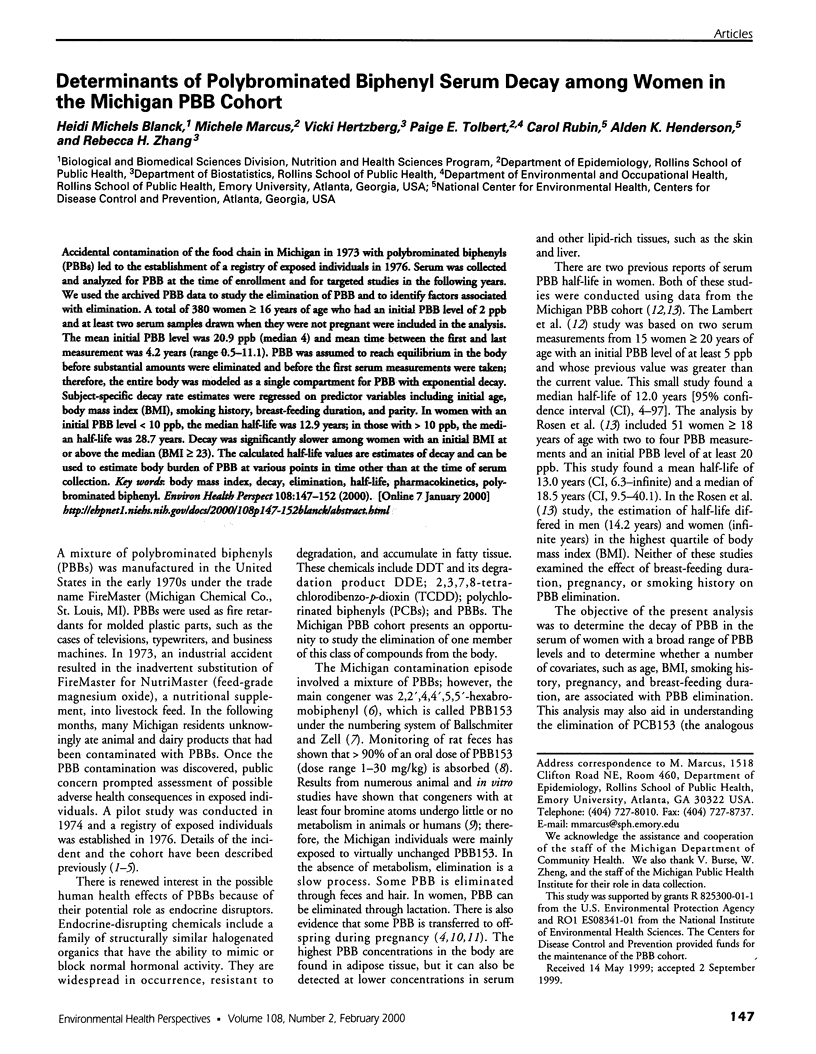
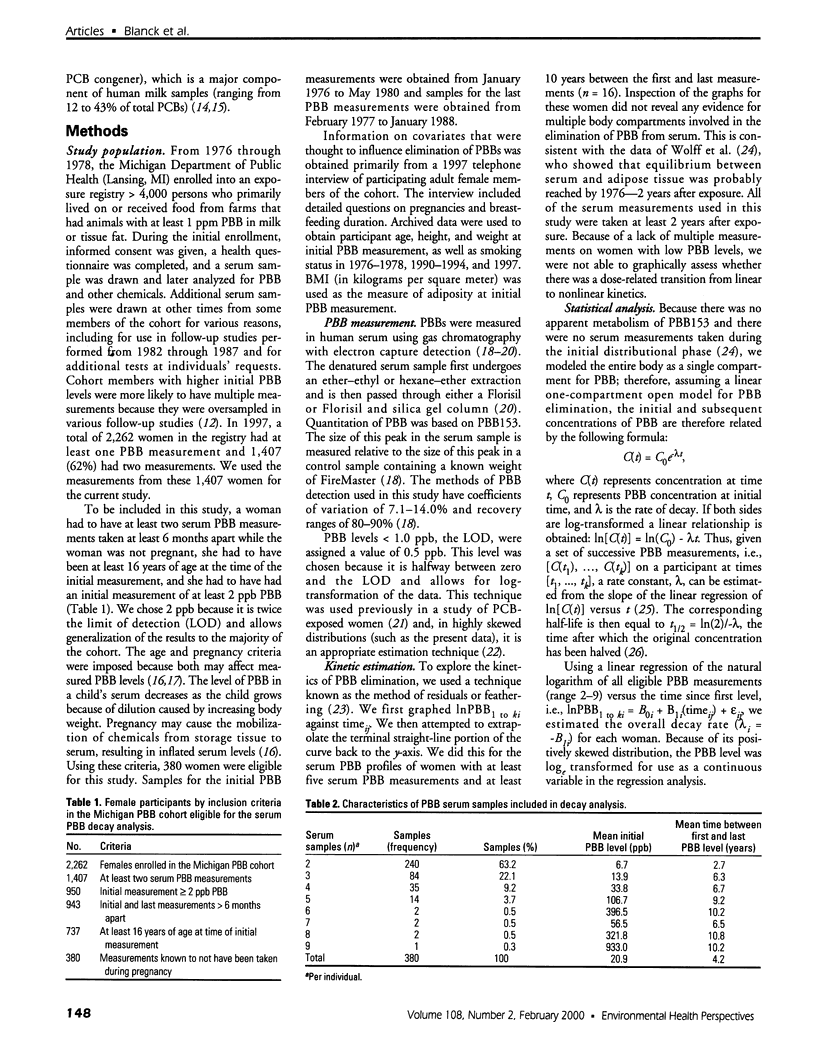

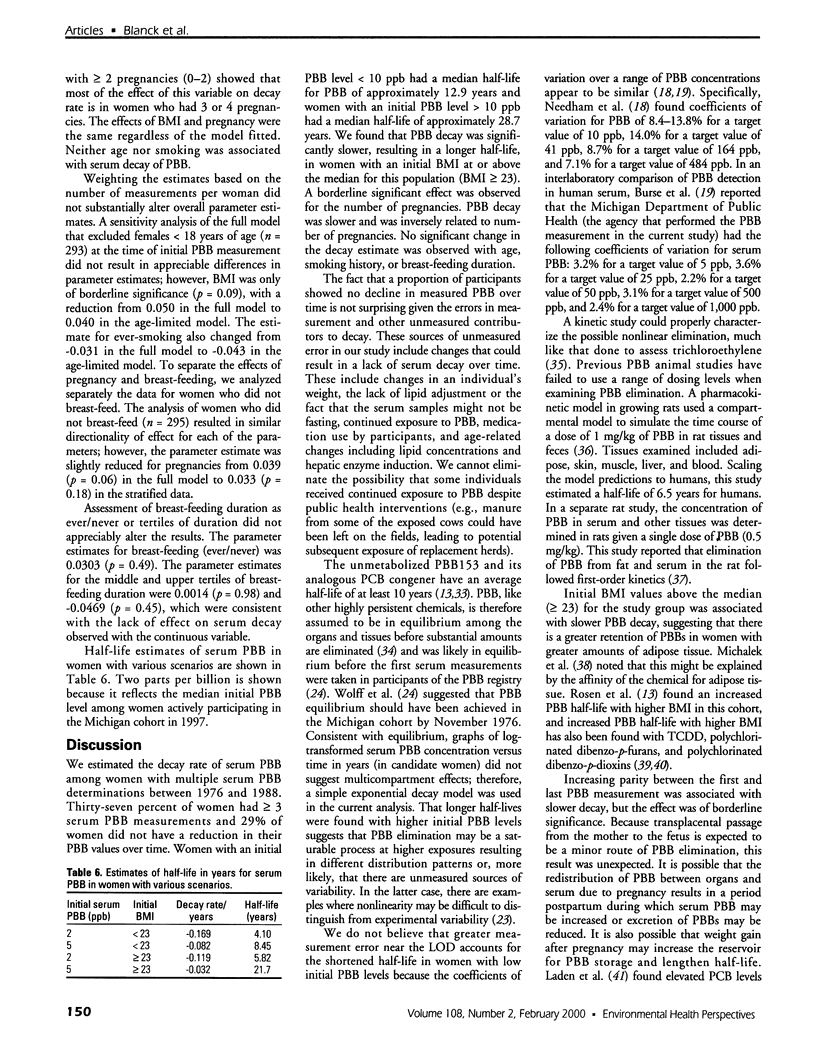
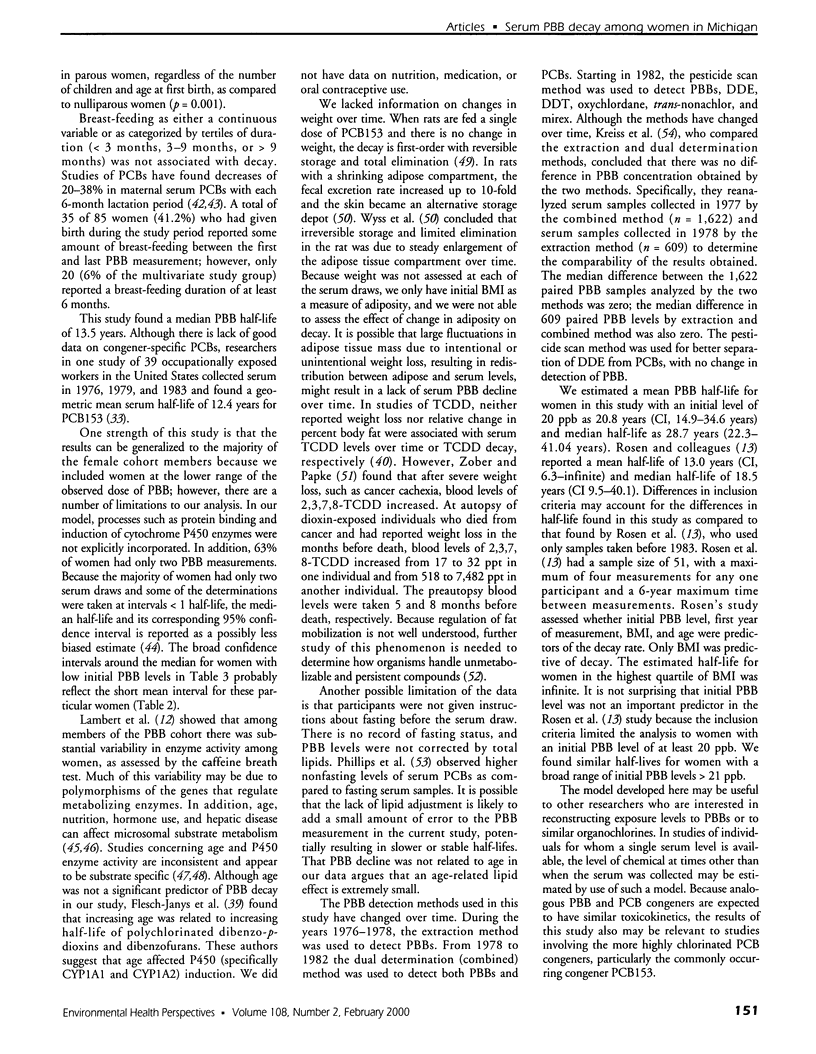
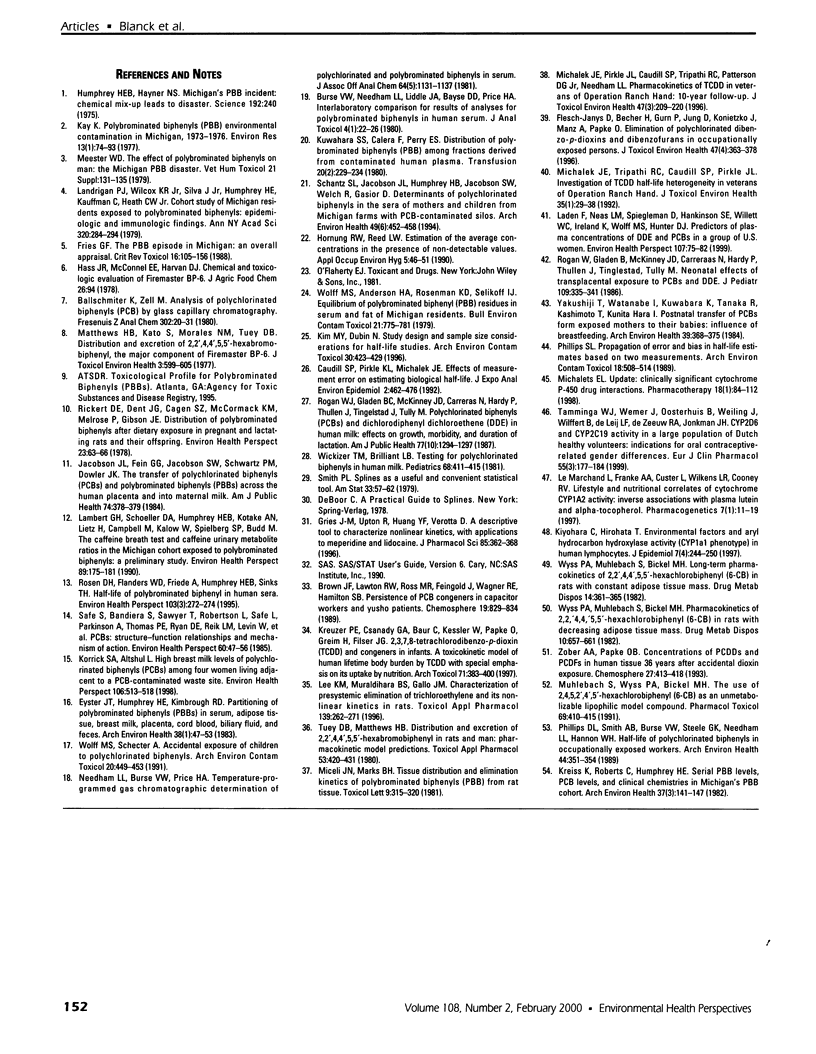
Selected References
These references are in PubMed. This may not be the complete list of references from this article.
- Burse V. W., Needham L. L., Liddle J. A., Bayse D. D., Price H. A. Interlaboratory comparison for results of analyses for polybrominated biphenyls in human serum. J Anal Toxicol. 1980 Jan-Feb;4(1):22–26. doi: 10.1093/jat/4.1.22. [DOI] [PubMed] [Google Scholar]
- Caudill S. P., Pirkle J. L., Michalek J. E. Effects of measurement error on estimating biological half-life. J Expo Anal Environ Epidemiol. 1992 Oct-Dec;2(4):463–476. [PubMed] [Google Scholar]
- Eyster J. T., Humphrey H. E., Kimbrough R. D. Partitioning of polybrominated biphenyls (PBBs) in serum, adipose tissue, breast milk, placenta, cord blood, biliary fluid, and feces. Arch Environ Health. 1983 Jan-Feb;38(1):47–53. doi: 10.1080/00039896.1983.10543978. [DOI] [PubMed] [Google Scholar]
- Flesch-Janys D., Becher H., Gurn P., Jung D., Konietzko J., Manz A., Päpke O. Elimination of polychlorinated dibenzo-p-dioxins and dibenzofurans in occupationally exposed persons. J Toxicol Environ Health. 1996 Mar;47(4):363–378. doi: 10.1080/009841096161708. [DOI] [PubMed] [Google Scholar]
- Fries G. F. The PBB episode in Michigan: an overall appraisal. Crit Rev Toxicol. 1985;16(2):105–156. doi: 10.3109/10408448509056268. [DOI] [PubMed] [Google Scholar]
- Gries J. M., Upton R., Huang Y. F., Verotta D. A descriptive tool to characterize nonlinear kinetics, with applications to meperidine and lidocaine. J Pharm Sci. 1996 Apr;85(4):362–368. doi: 10.1021/js950232+. [DOI] [PubMed] [Google Scholar]
- Hass J. R., McConnell E. E., Harvan D. J. Chemical and toxicologic evaluation of firemaster BP-6. J Agric Food Chem. 1978 Jan-Feb;26(1):94–99. doi: 10.1021/jf60215a006. [DOI] [PubMed] [Google Scholar]
- Jacobson J. L., Fein G. G., Jacobson S. W., Schwartz P. M., Dowler J. K. The transfer of polychlorinated biphenyls (PCBs) and polybrominated biphenyls (PBBs) across the human placenta and into maternal milk. Am J Public Health. 1984 Apr;74(4):378–379. doi: 10.2105/ajph.74.4.378. [DOI] [PMC free article] [PubMed] [Google Scholar]
- Kay K. Polybrominated biphenyls (PBB) environmental contamination in Michigan, 1973-1976. Environ Res. 1977 Feb;13(1):74–93. doi: 10.1016/0013-9351(77)90006-8. [DOI] [PubMed] [Google Scholar]
- Kim M. Y., Dubin N. Study design and sample size considerations for half-life studies. Arch Environ Contam Toxicol. 1996 Mar;30(3):423–429. doi: 10.1007/BF00212304. [DOI] [PubMed] [Google Scholar]
- Kiyohara C., Hirohata T. Environmental factors and aryl hydrocarbon hydroxylase activity (CYP1A1 phenotype) in human lymphocytes. J Epidemiol. 1997 Dec;7(4):244–250. doi: 10.2188/jea.7.244. [DOI] [PubMed] [Google Scholar]
- Korrick S. A., Altshul L. High breast milk levels of polychlorinated biphenyls (PCBs) among four women living adjacent to a PCB-contaminated waste site. Environ Health Perspect. 1998 Aug;106(8):513–518. doi: 10.1289/ehp.98106513. [DOI] [PMC free article] [PubMed] [Google Scholar]
- Kreiss K., Roberts C., Humphrey H. E. Serial PBB levels, PCB levels, and clinical chemistries in Michigan's PBB cohort. Arch Environ Health. 1982 May-Jun;37(3):141–147. doi: 10.1080/00039896.1982.10667553. [DOI] [PubMed] [Google Scholar]
- Kreuzer P. E., Csanády G. A., Baur C., Kessler W., Päpke O., Greim H., Filser J. G. 2,3,7,8-Tetrachlorodibenzo-p-dioxin (TCDD) and congeners in infants. A toxicokinetic model of human lifetime body burden by TCDD with special emphasis on its uptake by nutrition. Arch Toxicol. 1997;71(6):383–400. doi: 10.1007/s002040050402. [DOI] [PubMed] [Google Scholar]
- Kuwahara S. S., Calera F., Perry E. S. Distribution of polybrominated biphenyls (PBB) among fractions derived from contaminated human plasma. Transfusion. 1980 Mar-Apr;20(2):229–234. doi: 10.1046/j.1537-2995.1980.20280169967.x. [DOI] [PubMed] [Google Scholar]
- Laden F., Neas L. M., Spiegelman D., Hankinson S. E., Willett W. C., Ireland K., Wolff M. S., Hunter D. J. Predictors of plasma concentrations of DDE and PCBs in a group of U.S. women. Environ Health Perspect. 1999 Jan;107(1):75–81. doi: 10.1289/ehp.9910775. [DOI] [PMC free article] [PubMed] [Google Scholar]
- Lambert G. H., Schoeller D. A., Humphrey H. E., Kotake A. N., Lietz H., Campbell M., Kalow W., Spielberg S. P., Budd M. The caffeine breath test and caffeine urinary metabolite ratios in the Michigan cohort exposed to polybrominated biphenyls: a preliminary study. Environ Health Perspect. 1990 Nov;89:175–181. doi: 10.1289/ehp.9089175. [DOI] [PMC free article] [PubMed] [Google Scholar]
- Landrigan P. J., Wilcox K. R., Jr, Silva J., Jr, Humphrey H. E., Kauffman C., Heath C. W., Jr Cohort study of Michigan residents exposed to polybrominated biphenyls: epidemiologic and immunologic findings. Ann N Y Acad Sci. 1979 May 31;320:284–294. doi: 10.1111/j.1749-6632.1979.tb56611.x. [DOI] [PubMed] [Google Scholar]
- Le Marchand L., Franke A. A., Custer L., Wilkens L. R., Cooney R. V. Lifestyle and nutritional correlates of cytochrome CYP1A2 activity: inverse associations with plasma lutein and alpha-tocopherol. Pharmacogenetics. 1997 Feb;7(1):11–19. doi: 10.1097/00008571-199702000-00002. [DOI] [PubMed] [Google Scholar]
- Lee K. M., Bruckner J. V., Muralidhara S., Gallo J. M. Characterization of presystemic elimination of trichloroethylene and its nonlinear kinetics in rats. Toxicol Appl Pharmacol. 1996 Aug;139(2):262–271. doi: 10.1006/taap.1996.0165. [DOI] [PubMed] [Google Scholar]
- Matthews H. B., Kato S., Morales N. M., Tuey D. B. Distribution and excretion of 2,4,5,2',4',5'-hexabromobiphenyl, the major component of Firemaster BP-6. J Toxicol Environ Health. 1977 Oct;3(3):599–605. doi: 10.1080/15287397709529592. [DOI] [PubMed] [Google Scholar]
- Meester W. D. The effect of polybrominated biphenyls on man: the Michigan PBB disaster. Vet Hum Toxicol. 1979;21 (Suppl):131–135. [PubMed] [Google Scholar]
- Miceli J. N., Marks B. H. Tissue distribution and elimination kinetics of polybrominated biphenyls (PBB) from rat tissue. Toxicol Lett. 1981 Dec;9(4):315–320. doi: 10.1016/0378-4274(81)90003-5. [DOI] [PubMed] [Google Scholar]
- Michalek J. E., Pirkle J. L., Caudill S. P., Tripathi R. C., Patterson D. G., Jr, Needham L. L. Pharmacokinetics of TCDD in veterans of Operation Ranch Hand: 10-year follow-up. J Toxicol Environ Health. 1996 Feb 23;47(3):209–220. doi: 10.1080/009841096161744. [DOI] [PubMed] [Google Scholar]
- Michalek J. E., Tripathi R. C., Caudill S. P., Pirkle J. L. Investigation of TCDD half-life heterogeneity in veterans of Operation Ranch Hand. J Toxicol Environ Health. 1992 Jan;35(1):29–38. doi: 10.1080/15287399209531591. [DOI] [PubMed] [Google Scholar]
- Michalets E. L. Update: clinically significant cytochrome P-450 drug interactions. Pharmacotherapy. 1998 Jan-Feb;18(1):84–112. [PubMed] [Google Scholar]
- Mühlebach S., Wyss P. A., Bickel M. H. The use of 2,4,5,2',4',5'-hexachlorobiphenyl (6-CB) as an unmetabolizable lipophilic model compound. Pharmacol Toxicol. 1991 Dec;69(6):410–415. doi: 10.1111/j.1600-0773.1991.tb01322.x. [DOI] [PubMed] [Google Scholar]
- Needham L. L., Burse V. W., Price H. A. Temperature-programmed gas chromatographic determination of polychlorinated and polybrominated biphenyls in serum. J Assoc Off Anal Chem. 1981 Sep;64(5):1131–1137. [PubMed] [Google Scholar]
- Phillips D. L. Propagation of error and bias in half-life estimates based on two measurements. Arch Environ Contam Toxicol. 1989 Jul-Aug;18(4):508–514. doi: 10.1007/BF01055017. [DOI] [PubMed] [Google Scholar]
- Phillips D. L., Smith A. B., Burse V. W., Steele G. K., Needham L. L., Hannon W. H. Half-life of polychlorinated biphenyls in occupationally exposed workers. Arch Environ Health. 1989 Nov-Dec;44(6):351–354. doi: 10.1080/00039896.1989.9935905. [DOI] [PubMed] [Google Scholar]
- Rickert D. E., Dent J. G., Cagen S. Z., McCormack K. M., Melrose P., Gibson J. E. Distribution of polybrominated biphenyls after dietary exposure in pregnant and lactating rats and their offspring. Environ Health Perspect. 1978 Apr;23:63–66. doi: 10.1289/ehp.782363. [DOI] [PMC free article] [PubMed] [Google Scholar]
- Rogan W. J., Gladen B. C., McKinney J. D., Carreras N., Hardy P., Thullen J., Tingelstad J., Tully M. Polychlorinated biphenyls (PCBs) and dichlorodiphenyl dichloroethene (DDE) in human milk: effects on growth, morbidity, and duration of lactation. Am J Public Health. 1987 Oct;77(10):1294–1297. doi: 10.2105/ajph.77.10.1294. [DOI] [PMC free article] [PubMed] [Google Scholar]
- Rogan W. J., Gladen B. C., McKinney J. D., Carreras N., Hardy P., Thullen J., Tinglestad J., Tully M. Neonatal effects of transplacental exposure to PCBs and DDE. J Pediatr. 1986 Aug;109(2):335–341. doi: 10.1016/s0022-3476(86)80397-3. [DOI] [PubMed] [Google Scholar]
- Rosen D. H., Flanders W. D., Friede A., Humphrey H. E., Sinks T. H. Half-life of polybrominated biphenyl in human sera. Environ Health Perspect. 1995 Mar;103(3):272–274. doi: 10.1289/ehp.95103272. [DOI] [PMC free article] [PubMed] [Google Scholar]
- Safe S., Bandiera S., Sawyer T., Robertson L., Safe L., Parkinson A., Thomas P. E., Ryan D. E., Reik L. M., Levin W. PCBs: structure-function relationships and mechanism of action. Environ Health Perspect. 1985 May;60:47–56. doi: 10.1289/ehp.856047. [DOI] [PMC free article] [PubMed] [Google Scholar]
- Schantz S. L., Jacobson J. L., Humphrey H. E., Jacobson S. W., Welch R., Gasior D. Determinants of polychlorinated biphenyls (PCBs) in the sera of mothers and children from Michigan farms with PCB-contaminated silos. Arch Environ Health. 1994 Nov-Dec;49(6):452–458. doi: 10.1080/00039896.1994.9955000. [DOI] [PubMed] [Google Scholar]
- Sturk A., van Deventer S. J., Wortel C. H., Levels J. H., ten Cate J. W., Büller H. R., Sanders G. T. Detection and clinical relevance of human endotoxemia. Z Med Lab Diagn. 1990;31(3):147–158. [PubMed] [Google Scholar]
- Tamminga W. J., Wemer J., Oosterhuis B., Weiling J., Wilffert B., de Leij L. F., de Zeeuw R. A., Jonkman J. H. CYP2D6 and CYP2C19 activity in a large population of Dutch healthy volunteers: indications for oral contraceptive-related gender differences. Eur J Clin Pharmacol. 1999 May;55(3):177–184. doi: 10.1007/s002280050615. [DOI] [PubMed] [Google Scholar]
- Tuey D. B., Matthews H. B. Distribution and excretion of 2,2',4,4',5,5'-hexabromobiphenyl in rats and man: pharmacokinetic model predictions. Toxicol Appl Pharmacol. 1980 May;53(3):420–431. doi: 10.1016/0041-008x(80)90355-5. [DOI] [PubMed] [Google Scholar]
- Wedeking P., Carlton P. L. Habituation and sensitization in the modulation of reflex amplitude. Physiol Behav. 1979 Jan;22(1):57–62. doi: 10.1016/0031-9384(79)90404-9. [DOI] [PubMed] [Google Scholar]
- Wickizer T. M., Brilliant L. B. Testing for polychlorinated biphenyls in human milk. Pediatrics. 1981 Sep;68(3):411–415. [PubMed] [Google Scholar]
- Wolff M. S., Anderson H. A., Rosenman K. D., Selikoff I. J. Equilibrium of polybrominated biphenyl (PBB) residues in serum and fat of Michigan residents. Bull Environ Contam Toxicol. 1979 Apr;21(6):775–781. doi: 10.1007/BF01685504. [DOI] [PubMed] [Google Scholar]
- Wolff M. S., Schecter A. Accidental exposure of children to polychlorinated biphenyls. Arch Environ Contam Toxicol. 1991 May;20(4):449–453. doi: 10.1007/BF01065832. [DOI] [PubMed] [Google Scholar]
- Wyss P. A., Mühlebach S., Bickel M. H. Long-term pharmacokinetics of 2,2',4,4',5,5'-hexachlorobiphenyl (6-CB) in rats with constant adipose tissue mass. Drug Metab Dispos. 1986 May-Jun;14(3):361–365. [PubMed] [Google Scholar]
- Wyss P. A., Mühlebach S., Bickel M. H. Pharmacokinetics of 2,2',4,4',5,5'-hexachlorobiphenyl (6-CB) in rats with decreasing adipose tissue mass. I. Effects of restricting food intake two weeks after administration of 6-CB. Drug Metab Dispos. 1982 Nov-Dec;10(6):657–661. [PubMed] [Google Scholar]
- Yakushiji T., Watanabe I., Kuwabara K., Tanaka R., Kashimoto T., Kunita N., Hara I. Postnatal transfer of PCBs from exposed mothers to their babies: influence of breast-feeding. Arch Environ Health. 1984 Sep-Oct;39(5):368–375. doi: 10.1080/00039896.1984.10545866. [DOI] [PubMed] [Google Scholar]


